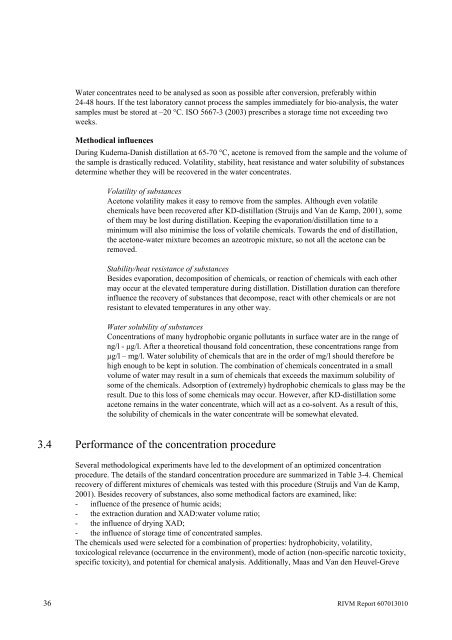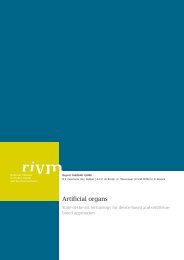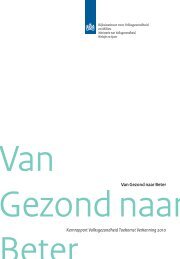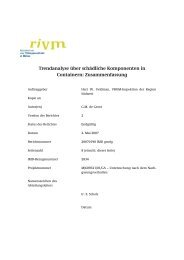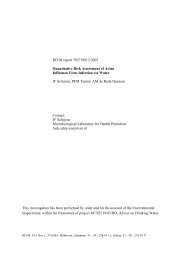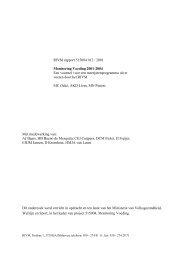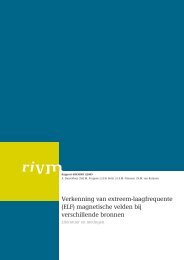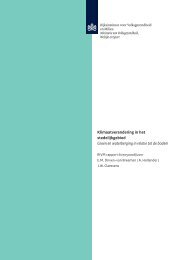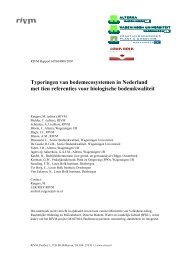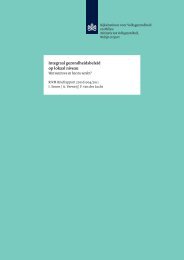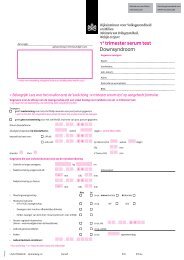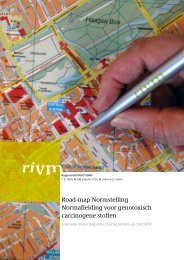Toxicity measurements in concentrated water samples - Rivm
Toxicity measurements in concentrated water samples - Rivm
Toxicity measurements in concentrated water samples - Rivm
You also want an ePaper? Increase the reach of your titles
YUMPU automatically turns print PDFs into web optimized ePapers that Google loves.
Water concentrates need to be analysed as soon as possible after conversion, preferably with<strong>in</strong><br />
24-48 hours. If the test laboratory cannot process the <strong>samples</strong> immediately for bio-analysis, the <strong>water</strong><br />
<strong>samples</strong> must be stored at –20 °C. ISO 5667-3 (2003) prescribes a storage time not exceed<strong>in</strong>g two<br />
weeks.<br />
Methodical <strong>in</strong>fluences<br />
Dur<strong>in</strong>g Kuderna-Danish distillation at 65-70 °C, acetone is removed from the sample and the volume of<br />
the sample is drastically reduced. Volatility, stability, heat resistance and <strong>water</strong> solubility of substances<br />
determ<strong>in</strong>e whether they will be recovered <strong>in</strong> the <strong>water</strong> concentrates.<br />
Volatility of substances<br />
Acetone volatility makes it easy to remove from the <strong>samples</strong>. Although even volatile<br />
chemicals have been recovered after KD-distillation (Struijs and Van de Kamp, 2001), some<br />
of them may be lost dur<strong>in</strong>g distillation. Keep<strong>in</strong>g the evaporation/distillation time to a<br />
m<strong>in</strong>imum will also m<strong>in</strong>imise the loss of volatile chemicals. Towards the end of distillation,<br />
the acetone-<strong>water</strong> mixture becomes an azeotropic mixture, so not all the acetone can be<br />
removed.<br />
Stability/heat resistance of substances<br />
Besides evaporation, decomposition of chemicals, or reaction of chemicals with each other<br />
may occur at the elevated temperature dur<strong>in</strong>g distillation. Distillation duration can therefore<br />
<strong>in</strong>fluence the recovery of substances that decompose, react with other chemicals or are not<br />
resistant to elevated temperatures <strong>in</strong> any other way.<br />
Water solubility of substances<br />
Concentrations of many hydrophobic organic pollutants <strong>in</strong> surface <strong>water</strong> are <strong>in</strong> the range of<br />
ng/l - µg/l. After a theoretical thousand fold concentration, these concentrations range from<br />
µg/l – mg/l. Water solubility of chemicals that are <strong>in</strong> the order of mg/l should therefore be<br />
high enough to be kept <strong>in</strong> solution. The comb<strong>in</strong>ation of chemicals <strong>concentrated</strong> <strong>in</strong> a small<br />
volume of <strong>water</strong> may result <strong>in</strong> a sum of chemicals that exceeds the maximum solubility of<br />
some of the chemicals. Adsorption of (extremely) hydrophobic chemicals to glass may be the<br />
result. Due to this loss of some chemicals may occur. However, after KD-distillation some<br />
acetone rema<strong>in</strong>s <strong>in</strong> the <strong>water</strong> concentrate, which will act as a co-solvent. As a result of this,<br />
the solubility of chemicals <strong>in</strong> the <strong>water</strong> concentrate will be somewhat elevated.<br />
3.4 Performance of the concentration procedure<br />
Several methodological experiments have led to the development of an optimized concentration<br />
procedure. The details of the standard concentration procedure are summarized <strong>in</strong> Table 3-4. Chemical<br />
recovery of different mixtures of chemicals was tested with this procedure (Struijs and Van de Kamp,<br />
2001). Besides recovery of substances, also some methodical factors are exam<strong>in</strong>ed, like:<br />
- <strong>in</strong>fluence of the presence of humic acids;<br />
- the extraction duration and XAD:<strong>water</strong> volume ratio;<br />
- the <strong>in</strong>fluence of dry<strong>in</strong>g XAD;<br />
- the <strong>in</strong>fluence of storage time of <strong>concentrated</strong> <strong>samples</strong>.<br />
The chemicals used were selected for a comb<strong>in</strong>ation of properties: hydrophobicity, volatility,<br />
toxicological relevance (occurrence <strong>in</strong> the environment), mode of action (non-specific narcotic toxicity,<br />
specific toxicity), and potential for chemical analysis. Additionally, Maas and Van den Heuvel-Greve<br />
36 RIVM Report 607013010


